MIT-SCIENCE-Lectures-drkp_tn_al_nul
MIT-SCIENCE-Lectures-13bingopretverbreg
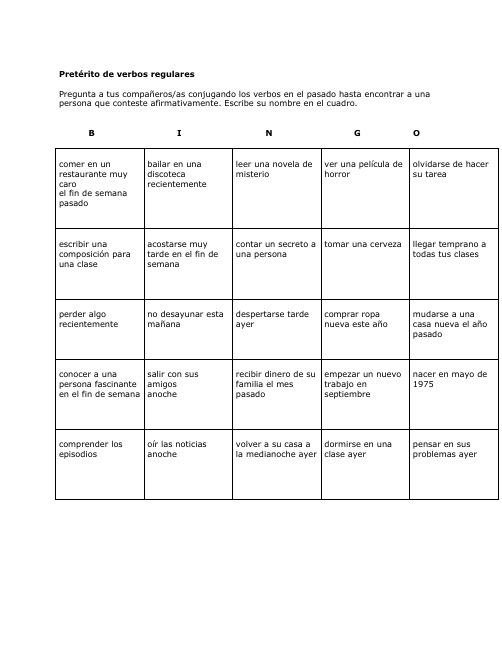
Pretérito de verbos regularesPregunta a tus compañeros/as conjugando los verbos en el pasado hasta encontrar a una persona que conteste afirmativamente. Escribe su nombre en el cuadro.B I N G Ocomer en un restaurante muy caroel fin de semana pasado bailar en unadiscotecarecientementeleer una novela demisteriover una película dehorrorolvidarse de hacersu tareaescribir una composición para una clase acostarse muytarde en el fin desemanacontar un secreto auna personatomar una cerveza llegar temprano atodas tus clasesperder algo recientemente no desayunar estamañanadespertarse tardeayercomprar ropanueva este añomudarse a unacasa nueva el añopasadoconocer a una persona fascinante en el fin de semana salir con susamigosanocherecibir dinero de sufamilia el mespasadoempezar un nuevotrabajo enseptiembrenacer en mayo de1975comprender los episodios oír las noticiasanochevolver a su casa ala medianoche ayerdormirse en unaclase ayerpensar en susproblemas ayerB I N G Orevelar un secreto pensar en tufamilia anoche pasear por elparqueescribir un poemade amorsentirse mal ayerconocer a una persona importante desayunarmuy bien estamañananacer en 1977 discutir con tucompañero(a) decuartoleer un artículointeresantever una buena película ayudar a un amigo ganar la lotería elaño pasadosalir con tusamigos el viernespor la nochedescubrir unsecretovivir en unpaís extranjero (foreign country) prometerayudar a unapersonacontar una chiste(joke) muycómicooír un chisme muyescandalosocenar en unrestaurante muyeleganteaprender mucho en tus clases el año pasado olvidarse de hacersu tarea la semanapasadasalir muy bien enun examen muydifícilestudiar muchoayercomprar unacamisa nuevala semana pasada。
MIT-SCIENCE-Lectures-intro_sts_p12003

INTRODUCTION TO STATISTICS FOR POLITICAL SCIENCE:1.IntroductionStephen AnsolabehereDepartment of Political ScienceMassachusetts Institute of TechnologyFall,20031.IntroductionStatistical tools are essential for social scientists.Basic concepts of statistics,especially randomness and averaging,provide the foundations for measuring concepts,designing stud-ies,estimating quantities of interest,and testing theories and conjectures.People are not always good statisticians.It is hard to maintain discipline in observing the world.W e often learn from what is convenient-a violation of random sampling.We often do not calculate averages well.To learn these concepts with the depth associated with a graduate education-where you will have the facility to use these concepts in your own research and possibly contribute to the development of statistical models that others may use-requires some mathematics.We will use,repeatedly,three sorts of functions-polynomials(especially quadratics),exponentials, and logarithms.We will also use summation,as that is necessary for the calculation of averages,and summation comes in two forms-discrete and continuous(or integration).We will use di®erencing and di®erentiation(the continuous version of di®erencing).Finally,we will use probability a special branch of mathematics designed to study uncertainty.This course is designed to be a self-contained introduction not only to the concepts but also to the tools of statistics for social sciences.At the beginning of this course I will review the basic mathematical tools used in statistics.As a result we will study calculus and probability theory.Much of the basic mathematics that social scientists use in statistical analyses and in formal modeling comes from the calculus,especially limits,derivatives,and integrals.Probability provides a theory of uncertainty,and is thus the essential tool of statistics.1.Two core ideas in statistics.A.AveragingStatistics involves studying the frequencies of events and behaviors.W e assume that every event has its own likelihood of occurence,such as the likelihoodof the birth of a boy or girl.The long-run average is a measure of that frequency.One important law of statistics is the Law of Large Numbers.If we observe the repetition of a certain trial or experiment or event,such as birth,the long-run frequency with which one outcome or another happens,such as a boy or a girl is born,is extremely close to the true frequency of that outcome.A second important law of statistics is the Central Limit Theorem,which states that the frequency of possible outcomes of a sum of variables follows a bell-shaped(or normal)curve.We will make both of these laws more precise later in the course.B.RandomnessProbability is the study of randomness and chance.The systematic study of probability emerged as an important mathematical subject of study in the18th Century.In the late 18th and19th Centuries the application of probability spread beyond games of chance to the study of physical and social behavior.And in the20th Century researchers realized that one could use randomness to increase the e±ciency with which we learn.That is perhaps the most surprising and counter intuitive aspect of statistics{randomness is useful.Two core applications of this idea are(1)random sample surveys and(2)randomized experiments.1.Random Sample Surveys:How can we learn about100million people with just1000?Random sample surveys are the most widely used tool for measuring quantities of interest in all of the social sciences.Nearly all government data are collected using random sample surveys-including measures of the economic and social conditions of the nation,ranging from crime to in°ation to income and poverty to public health.Random sample surveys are staples of political organizations and academics interested in understanding national opinion about important public policies and public o±cials.How do random sample surveys work?A relatively small group of people are chosen at random and interviewed.The average answer to a particular question in a random sample istaken to represent or measure the average answer to that question in the entire population from which the sample is taken.How many people are to be interviewed and what they are to be asked is a matter of choice for the social scientist.But,the power of the random sample survey is that random choice of individuals gives the researcher leverage-allowing for great economy in the study of populations.2.Randomized ExperimentsPeople have conducted controlled experiments for centuries,especially using physical ob-jects.Controls involving creating conditions in which all other factors are held constant. Even with the best controlled experiments,it is possible to leave some potentially important factor uncontrolled.Such uncontrolled factors might create spurious relations or mask im-portant e®ects.Perhaps the most profound contribution of probability theory to scienti¯c study of social and physical behavior is the notion that random assignment of individuals to di®erent experimental conditions(such as receiving a drug or receiving a placebo)can reduce or even eliminate the threat of spurious e®ects.2.Fundamentals of Research MethodsA.Measurement and Estimation1.Concepts and Variables{the constructs or behavior we wish to understand.A good example is\inequality."Exercise:De¯ne inequality.2.Measures{the mathematical representation of the concept.For example,the income distribution in a society might be used to measure inequality.Exercise:devise a measure of the total amount of income inequality in a country.3.Measurement Theory{what requirements do we impose on our measurement device.(i)accuracy(with enough observations we would arrive at the correct answer),(ii) precision(low noise),(iii)reliability(can replicate).B.Model Building1.E®ects and Behavioral RelationshipsSocial scientists freqently want to measure the e®ect of one factor on another.There are many such examples.What is the e®ect of police on crime?What is the e®ect of additional military force on the probability of winning a battle or war?How does class size a®ect educational performance?How do electoral rules,such as single member districts,translate votes into legislative seats?In each case,there is one factor whose levels or values we would like to vary,such as the number of police,in order to observe changes in a second factors,such as the crime rate. The¯rst factor we call an independent variable,and the second factor,a dependent variable.2.AccountingWe seek to make a complete accounting of behavior.In this respect we value models in which a set of variables has high explanatory power.W e also demand parsimony:simpler is better.Example.Housing sales prices can be predicted very well as a function of list prices.In a normal market sales prices are92percent of list prices,and the¯t is extremely good.3.Equilibrium ConceptsMany ideas and conjectures about how social relations produce outcomes:maximizing behavior,dynamic adjustment,e±cient markets,or natural selection.The forces that cre-ate social outcomes make it di±cult to give causal interpretations to observed e®ects or relationships.C.InferenceA fundamental methodological problem is knowing when you should go with one argu-ment or idea or a competing argument or idea.When we measure phenomena,we often thenuse the measurements to draw inferences about di®erent ideas.Are data consistent with an argument or idea?What conclusions can we draw about theories from data?In the end, then,statistics involves a bit of decision theory.Predictions of a theory or conjectures about the world are called hypotheses.When specifying hypotheses it is important to be clear about all of the possible values.In a court of criminal law,hypotheses are questions of guilt or innocence.In medicine,hypotheses are about the condition of the patient,such as whether a cancer is benign or malignant or whether a woman is pregnant or not.In the scienti¯c method generally,the question is whether an conjecture is true or not.Unfortuantely,we never observe the truth.We use data to make decisions about hy-potheses.The evidence brought to a trial are data.A series of test are data.An academic study generates data.The problem of inference is how to use data to make decisions about hypotheses.Ultimately,that will depend on the value we place on di®erent sorts of outcomes from our decisions.However,we can formulate the problem we face quite simply.We want to make the correct decision,and we can make a correct decision one of two ways.First,we may decide,using the data,that the hypothesis is true and the state of the world is such that it is true.Second,we may decide,using the data,that the hypothesis is not true and the state of the world is such that the hypothesis is not true.W e may also make errors two ways.W e may decide that the hypothesis is true when it is in fact false or we may decided that the hypothesis is false when it is infact true.One a central objective of researchers is to avoid either of the two sorts of errors.Sta-tistical design is fundamentally about how to minimize the chances of making a mistaken judgment.。
MIT-SCIENCE-Lectures-class9_2002
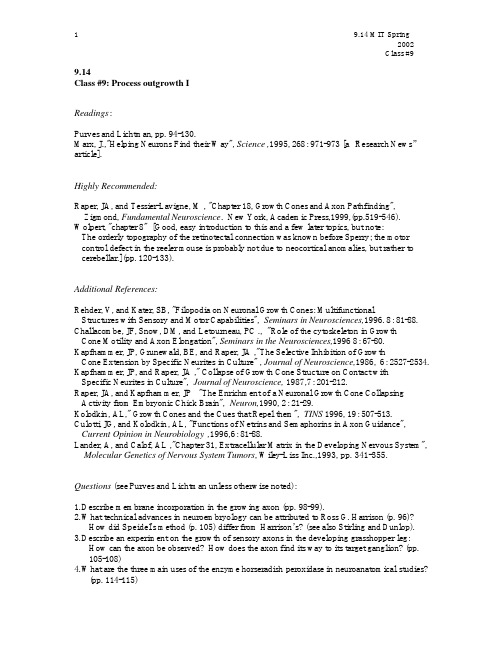
9.14Class #9: Process outgrowth IReadings:Purves and Lichtman, pp. 94-130.Marx, J.,"Helping Neurons Find their Way", Science ,1995, 268: 971-973 [a “Research News” article].Highly Recommended:Raper, JA, and Tessier-Lavigne, M , "Chapter 18, Growth Cones and Axon Pathfinding", Zigmond, Fundamental Neuroscience. New York, Academic Press,1999,(pp.519-546). Wolpert, "chapter 8" [Good, easy introduction to this and a few later topics, but note:The orderly topography of the retinotectal connection was known before Sperry; the motor control defect in the reeler mouse is probably not due to neocortical anomalies, but rather to cerebellar.](pp. 120-133).Additional References:Rehder, V, and Kater, SB, "Filopodia on Neuronal Growth Cones: MultifunctionalStructures with Sensory and Motor Capabilities", Seminars in Neurosciences,1996. 8: 81-88. Challacombe, JF, Snow, DM, and Letourneau, PC ., "Role of the cytoskeleton in GrowthCone Motility and Axon Elongation", Seminars in the Neurosciences,1996 8: 67-80. Kapfhammer, JP, Grunewald, BE, and Raper, JA ,"The Selective Inhibition of GrowthCone Extension by Specific Neurites in Culture" , Journal of Neuroscience,1986,6: 2527-2534. Kapfhammer, JP, and Raper, JA ," Collapse of Growth Cone Structure on Contact withSpecific Neurites in Culture", Journal of Neuroscience, 1987,7: 201-212.Raper, JA, and Kapfhammer, JP "The Enrichment of a Neuronal Growth Cone Collapsing Activity from Embryonic Chick Brain", Neuron,1990,2: 21-29.Kolodkin, AL," Growth Cones and the Cues that Repel them", TINS 1996,19: 507-513. Culotti, JG, and Kolodkin, AL, "Functions of Netrins and Semaphorins in Axon Guidance", Current Opinion in Neurobiology ,1996,6: 81-88.Lander, A, and Calof, AL ,"Chapter 31, Extracellular Matrix in the Developing Nervous System", Molecular Genetics of Nervous System Tumors, Wiley-Liss Inc.,1993, pp. 341-355.Questions (see Purves and Lichtman unless otherwise noted):1.Describe membrane incorporation in the growing axon (pp. 98-99).2.What technical advances in neuroembryology can be attributed to Ross G. Harrison (p. 96)?How did Speidel’s method (p. 105) differ from Harrison’s? (see also Stirling and Dunlop). 3.Describe an experiment on the growth of sensory axons in the developing grasshopper leg:How can the axon be observed? How does the axon find its way to its target ganglion? (pp.105-108)4.What are the three main uses of the enzyme horseradish peroxidase in neuroanatomical studies?(pp. 114-115)5.What is the major result in Hibbard’s experiment on transplanted amphibian Mauthner cells?(pp. 118-119)6.What are the four mechanisms of directed axon growth summarized by Purves and Lichtman?(pp. 119-129)7.Recent studies have distinguished four types of chemical guidance, adding new detail to theabove. What are they? (Marx) (p. 971)8.What is the apparent role of Semaphorin III (collapsin) in the innervation of the spinal cord bydorsal root axons? (973 fig.)9.Similarly, describe a role of the netrins in the formation of the spinothalamic tract (commisuralaxons from the dorsal horn neurons).。
MIT-SCIENCE-Lectures-RQ_Language
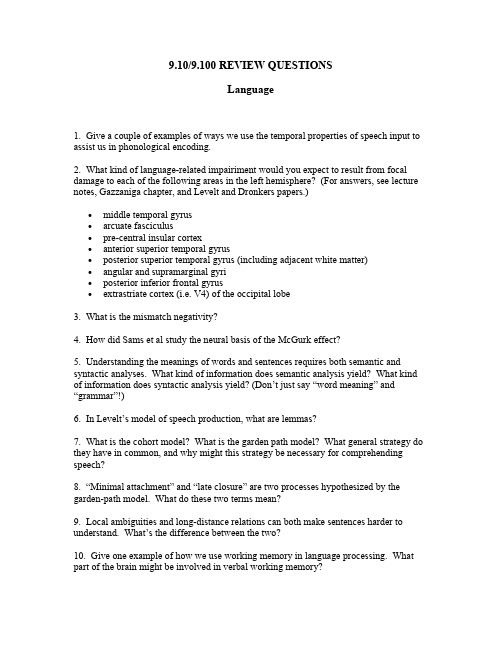
9.10/9.100 REVIEW QUESTIONSLanguage1. Give a couple of examples of ways we use the temporal properties of speech input to assist us in phonological encoding.2. What kind of language-related impairiment would you expect to result from focal damage to each of the following areas in the left hemisphere? (For answers, see lecture notes, Gazzaniga chapter, and Levelt and Dronkers papers.)•middle temporal gyrus•arcuate fasciculus•pre-central insular cortex•anterior superior temporal gyrus•posterior superior temporal gyrus (including adjacent white matter)•angular and supramarginal gyri•posterior inferior frontal gyrus•extrastriate cortex (i.e. V4) of the occipital lobe3. What is the mismatch negativity?4. How did Sams et al study the neural basis of the McGurk effect?5. Understanding the meanings of words and sentences requires both semantic and syntactic analyses. What kind of information does semantic analysis yield? What kind of information does syntactic analysis yield? (Don’t just say “word meaning” and “grammar”!)6. In Levelt’s model of speech production, what are lemmas?7. What is the cohort model? What is the garden path model? What general strategy do they have in common, and why might this strategy be necessary for comprehending speech?8. “Minimal attachment” and “late closure” are two processes hypothesized by the garden-path model. What do these two terms mean?9. Local ambiguities and long-distance relations can both make sentences harder to understand. What’s the difference between the two?10. Give one example of how we use working memory in language processing. What part of the brain might be involved in verbal working memory?11. There is general agreement that understanding written and spoken language involves multiple processing stages: lexical access, lexical selection, and lexical integration. Briefly describe what happens at each of these stages.12. What are some of the challenges involved in word-reading? How are these different from the challenges involved in processing speech?13. How was Levelt able to map the core processes of his language production model to different brain areas? What fundamental assumption did he have to make about the imaging studies he used in his meta-analysis?14. The stages or ‘core processes’ of Levelt’s model are listed below with their outputs. Be able to explain in plain English what happens at each stage, and what kind of information is contained in each output.PROCESS >> OUTPUTConceptual preparation >> lexical conceptLexical selection >> lemmaPhonological code retrieval >> phonological codePhonological encoding >> phonological wordPhonetic encoding >> gestural scoreArticulation >> spoken word15. How did Dronkers determine that the left pre-central insula is involved in articulation?16. What’s the difference between dysarthria and an impairment in articulation?。
MIT-SCIENCE-Lectures-exam2000
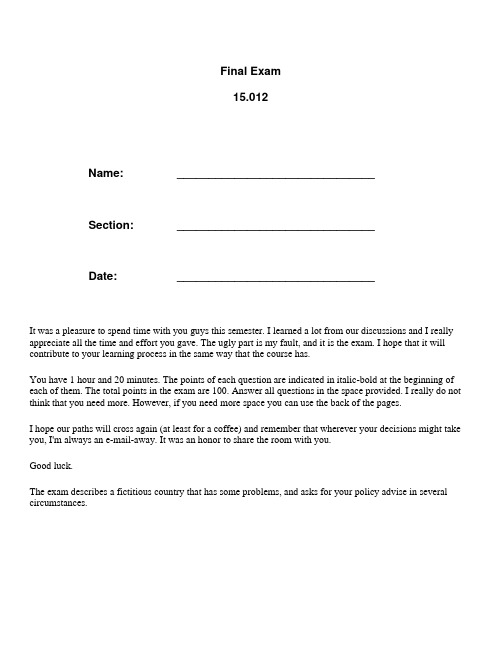
Final Exam15.012Name: _______________________________Section: _______________________________Date: _______________________________It was a pleasure to spend time with you guys this semester. I learned a lot from our discussions and I really appreciate all the time and effort you gave. The ugly part is my fault, and it is the exam. I hope that it will contribute to your learning process in the same way that the course has.You have 1 hour and 20 minutes. The points of each question are indicated in italic-bold at the beginning of each of them. The total points in the exam are 100. Answer all questions in the space provided. I really do not think that you need more. However, if you need more space you can use the back of the pages.I hope our paths will cross again (at least for a coffee) and remember that wherever your decisions might take you, I'm always an e-mail-away. It was an honor to share the room with you.Good luck.The exam describes a fictitious country that has some problems, and asks for your policy advise in several circumstances.Bonnet_land is a country that has performed appropriately in the last decades. Its major industry is themanufacturing of hats. The exports had been growing dramatically reflecting the increases in productivity thatthe industry had experienced in the past 30 years. The growth rate of the GDP per capital has also been quiteacceptable. Moreover, all this growth has been achieved with very responsible fiscal behavior (deficits areusually smaller than 1 percent of GDP), and low unemployment. This has allowed the monetary authority tomaintain a fixed exchange rate for a very long time. Since the seventies the economy has been characterized bylow inflation, relatively low interest rates, and equilibrium in the current account (the current account has beenconsistently positive).However, in the later part of the 90's growth has declined and unemployment has started to increase. Thecurrent account has also deteriorated and it is now barely positive. See table for all the data.19991990-961997-981980's1970'scapita) 3.1 2.3 1.9 0.1 -0.1Growth(perUnemployment 4.5 4.1 7.6 12.0 14.0Current/GDP 1.0 1.5 1.7 1.1 0.5AccountInflation 5.0 3.0 2.5 2.3 1.9Rates 7.0 8.3 6.5 7.2 7.1Interestwagegrowth 3.6 2.5 2.1 2.7 1.3Realdeficits -0.1 -0.5 -1.1 -2.6 -3.2FiscalThe increase in unemployment has been associated with the current welfare state and the decrease in the growthrate. In particular, several important economists in the country blame the unemployment insurance as the mainsource of the problem. Prof. Know_a_lot_busch describes the situation as: "The current welfare state wasdesigned for a growing economy. When this stopped, and real wages stagnated, and unemployment insurancebecame too attractive. Neither workers, nor firms, have incentives to create the necessary jobs to accommodatethe unemployed"A new president, Cap Boater, has taken office recently. He is crying for advice, and he has called you for help.1.- [10 pts] Give a diagnostic of the current situation of the economy in the BB-NN map.What would you do if you want to return immediately to the equilibrium (Hint: you will need at least two policies to move the economy directly to equilibrium)? Only describe fiscal, monetary and exchange rate policy. Do not indicate any reforms yet.2.- [10 pts] What are the benefits and costs of each of your policies:3.- [15 pts] Assume that no policies have been implemented yet. When you arrive to the country to advise the government, suddenly, there is a riot in the Capital. In fact, the current situation of large unemployment has driven a drop in the wage in dollars and people are starting to complain.The head of the Union, Pissed My Hood, is quite frustrated with the situation of their workers: "We cannot find a place to work, our wages are coming down, the people are dying, the people are hungry. What you expect them to do? Their economic situation is so bad that they are moving to Shirt_land" (Shirt_land is a really crummy country East of Bonet_land)Draw the situation of the economy and the social peace line.How you would change the policies you advised before (question 1)?4.- [20 pts] Assume that we are in the original situation (before any policy, but with the riots) and assume that an earthquake hits the country. Half of the capital is lost and production drops dramatically. The current account turns into a severe deficit.Several analysts have indicated that the current account deficit is dangerous for the viability of the country. As was mentioned by Prof. Parrot_man: "The current account deficit, together with a slow down in growth, and an increasing fiscal deficit indicates that this economy is going to hit the wall. When? I do not know, but they are going to hit it hard."Draw in the BB-NN what is the implication of the natural disaster (assume the lines in the diagram are the original lines before the earthquake).What are your policy recommendations in terms of monetary, fiscal and exchange rate policies (No reforms yet)?Policies:5.- [25 pts] If you have the chance to make ONE reform, what would you do? What would be the impact of it in the BB-NN? Please, only ONE reform.Reform: _______________________________________________________________________________Explain:6.- [20 pts] The earthquake has clearly debilitated the image of the country abroad and the interest rates have increased dramatically. The Prof. Know_a_lot_busch has said that the solution should be to move to Dollarize the economy. The Prof. Parrot_man has said that the devaluation and the shift to a flexible regime are the only viable policies.What would you do?Explain indicating the benefits and costs of your policy.。
MIT-SCIENCE-Lectures-class23_2002
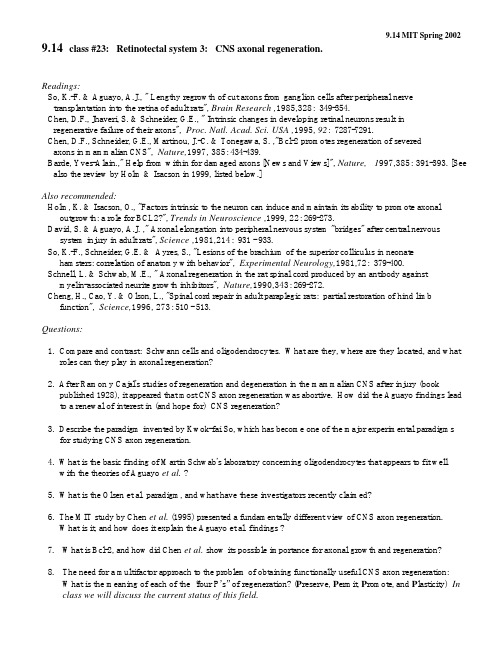
9.14 MIT Spring 2002 9.14 class #23: Retinotectal system 3: CNS axonal regeneration.Readings:So, K.-F. & Aguayo, A.J., " Lengthy regrowth of cut axons from ganglion cells after peripheral nervetransplantation into the retina of adult rats", Brain Research ,1985,328: 349-354.Chen, D.F., Jhaveri, S. & Schneider, G.E., " Intrinsic changes in developing retinal neurons result inregenerative failure of their axons", Proc. Natl. Acad. Sci. USA ,1995, 92: 7287-7291.Chen, D.F., Schneider, G.E., Martinou, J.-C. & Tonegawa, S. ,"Bcl-2 promotes regeneration of severedaxons in mammalian CNS", Nature,1997, 385: 434-439.Barde, Yves-Alain.," Help from within for damaged axons [News and Views]", Nature, 1997,385: 391-393. [See also the review by Holm & Isacson in 1999, listed below.]Also recommended:Holm, K. & Isacson, O., "Factors intrinsic to the neuron can induce and maintain its ability to promote axonal outgrowth: a role for BCL2?", Trends in Neuroscience ,1999, 22: 269-273.David, S. & Aguayo, A.J. ," Axonal elongation into peripheral nervous system "bridges" after central nervous system injury in adult rats", Science ,1981,214: 931 - 933.So, K.-F., Schneider, G.E. & Ayres, S., "Lesions of the brachium of the superior colliculus in neonate hamsters: correlation of anatomy with behavior",Experimental Neurology,1981,72: 379-400.Schnell, L. & Schwab, M.E., " Axonal regeneration in the rat spinal cord produced by an antibody against myelin-associated neurite growth inhibitors", Nature,1990,343: 269-272.Cheng, H., Cao, Y. & Olson, L., "Spinal cord repair in adult paraplegic rats: partial restoration of hind limb function", Science,1996, 273: 510 - 513.Questions:1. Compare and contrast: Schwann cells and oligodendrocytes. What are they, where are they located, and whatroles can they play in axonal regeneration?2. After Ramon y Cajal's studies of regeneration and degeneration in the mammalian CNS after injury (bookpublished 1928), it appeared that most CNS axon regeneration was abortive. How did the Aguayo findings lead to a renewal of interest in (and hope for) CNS regeneration?3. Describe the paradigm invented by Kwok-fai So, which has become one of the major experimental paradigmsfor studying CNS axon regeneration.4. What is the basic finding of Martin Schwab's laboratory concerning oligodendrocytes that appears to fit wellwith the theories of Aguayo et al. ?5. What is the Olsen et al. paradigm, and what have these investigators recently claimed?6. The MIT study by Chen et al. (1995) presented a fundamentally different view of CNS axon regeneration.What is it, and how does it explain the Aguayo et al. findings ?7. What is Bcl-2, and how did Chen et al. show its possible importance for axonal growth and regeneration?8. The need for a multifactor approach to the problem of obtaining functionally useful CNS axon regeneration:What is the meaning of each of the “four P’s” of regeneration? (P reserve, P ermit, P romote, and P lasticity) In class we will discuss the current status of this field.。
MIT-SCIENCE-Lectures-1_introduction
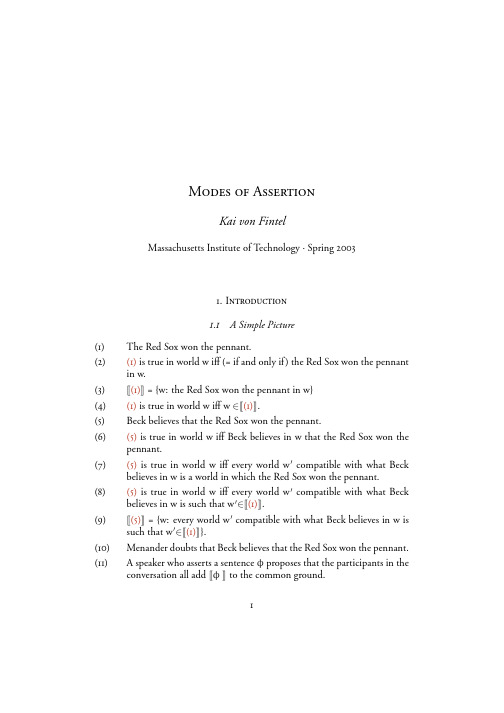
M odes of A ssertionKai von FintelMassachusetts Institute of T echnology·Spring20031.I ntroduction1.1A Simple Picture(1)The Red Sox won the pennant.(2)(1)is true in world w iff(=if and only if)the Red Sox won the pennantin w.(3) (1) ={w:the Red Sox won the pennant in w}(4)(1)is true in world w iffw∈ (1) .(5)Beck believes that the Red Sox won the pennant.(6)(5)is true in world w iffBeck believes in w that the Red Sox won thepennant.(7)(5)is true in world w iffevery world w compatible with what Beckbelieves in w is a world in which the Red Sox won the pennant. (8)(5)is true in world w iffevery world w compatible with what Beckbelieves in w is such that w ∈ (1) .(9) (5) ={w:every world w compatible with what Beck believes in w issuch that w ∈ (1) }.(10)Menander doubts that Beck believes that the Red Sox won the pennant.(11)A speaker who asserts a sentenceφproposes that the participants in theconversation all add φ to the common ground.1Modes of Assertion ::24.910::MIT Spring 2003Kai von Fintel(12)The common ground is a body of common assumptions that is meantto approximate "the truth".One hopes that the actual world is one of the worlds compatible with the common ground.1.2Modulation (13)The Red Sox won the pennant,I ⎧⎪⎪⎨⎪⎪⎩hear am sorry to say believe admit ⎫⎪⎪⎬⎪⎪⎭.(14)The Red Sox,(*as) I Mary believe(s),won the pennant.(15)The Red Sox ⎧⎪⎪⎨⎪⎪⎩apparently unfortunately definitely admittedly ⎫⎪⎪⎬⎪⎪⎭won the pennant.(16)The Red Sox won the pennant,which I had (not)expected Mary was glad to hear .(17)The Red Sox must mayhave won the pennant.(18)Here is a wild guess:the Red Sox won the pennant.(19)The damn Red Sox won the pennant.(20)The Red Sox “won”the pennant.(21)U rmson on “P arenthetical V erbs ”[W]hen these versb are used in the first person of the present tense,as is very clear when they occur grammatically in parenthesis,the assertion proper is contained in the indicative clause with which they are associ-ated,which is implied to be both true and reasonable.They themselves have not,in such a use,any descriptive sense but rather function as signals guiding the hearer to a proper appreciation of the statement in its context,social,logical,or evidential.They are not part of the state-ment made,nor additional statements,but function with regard to a statement made rather as ‘R ead with C are ’functions in relation to a subjoined notice,or as the foot stamping and saluting can function in the Army to make clear that one is making an o fficial report.PerhapsLecture Notes ::Part 1::Version 1.1::February 9,2003::21:32:372Modes of Assertion ::24.910::MIT Spring 2003Kai von Fintelthey can be compared to such stage-directions as ‘said in a mournful (confident)tone’with reference to the lines of the play.They help the understanding and assessment of what is said rather than being part of what is said.1.3Embedding(22) a.It is obvious that Parker made a big mistake.b.Parker, it is obvious obviously ,made a big mistake.(23)We have to fire him because he obviously made a big mistake.(24)We have to fire him because it is obvious that he made a big mistake.(25)If it is obvious that he made a big mistake,he will have to be fired.(26)If he obviously made a big mistake,he will have to be fired.(27)If the Red Sox,*(as) I Mary believe(s),won the pennant,I’ll order world series tickets.Suspicion:we need to distinguish parentheticals (side information,as in as I believe )from assertion modulators (as in I believe ).as I believe =which is what I believe –by the wayPerhaps,we should read:G reen ,M.S.:2000.“Illocutionary force and semantic content”.Linguistics and Philosophy 23(5):435–473(28)Task:compare all the di fferent devices on various kinds of embedding:a.John believes that ...b.Mary stayed home because ...c.If ...,the debate will be di fficult.d.&c.Lecture Notes ::Part 1::Version 1.1::February 9,2003::21:32:373Modes of Assertion::24.910::MIT Spring2003Kai von Fintel1.4More ComparisonsCompare to performatives:(29)I promise youfive dollars if you mow the lawn.(30)I pronounce you husband and wife.(31)I christen this ship“Prunella”.Compare to modal expressions:[...]1.5Evidentials(32)A nderson’s D efinition of“E videntials”(from Anderson1986)a.Evidentials show the kind of justification for a factual claim whichis available to the person making the claim.b.Evidentials are not themselves the main predication of the clause,but are rather a specification added to a factual claim about some-thing else.c.Evidentials have the indication of evidence as their primary mean-ing,not only as a pragmatic inference.d.Morphologically,evidentials are inflections,clitics,or other freesyntactic elements(not compounds or derivational forms).(33)T ypes of S ources of I nformation(from Willet1988)a.Direct–Attested–Visual/Auditory/Other Sensoryb.Indirect(i)Reported–Secondhand/Thirdhand/Folklore(ii)Inference–Results/ReasoningLecture Notes::Part1::Version1.1::February9,2003::21:32:374Modes of Assertion::24.910::MIT Spring2003Kai von FintelQuechua(34)-mia.Pilar bread-mi ateb.Woman-mi totally jumps aroundc.Lima-mi she travelled.d.Not-mi in my backpack it is.e.In the rainforest-mi,there are monkeys.f.In Africa-mi,there are elephants.(35)-cháa.Pilar know-house-chábe.(‘know-house’=school!)b.There is no rain.Now year not-chágood harvest be.(36)-sia.Marya knwo-house-si beb.some-si hit him(37)No evidentialPilar bread ate.Tibetan(38)Egoa.I teacher ego-beb.Yesterday I to his house ego-went(39)Directa.He left-directb.He now food eat-direct(40)Indirecta.He left-indirectb.today here wome tasty very indirect-ELPALecture Notes::Part1::Version1.1::February9,2003::21:32:375Modes of Assertion::24.910::MIT Spring2003Kai von FintelW riting A ssignment.Due:Feb25.Probably fairly short.Compare Quechua,Tibetan,and English with respect to the following three scenarios:A.You look out the window and see pouring rain.B.You see people in the hallway with dripping umbrellas.C.You wake up and the weather report on the radio says there is pouring rainin Cambridge.Which of the following English sentences can you use in which of the scenarios: (i)It’s raining.(ii)It must be raining.(iii)It’s raining,I guess.(iv)It’s raining,I hear.Based on the descriptions you have read so far(Chapter1of both theses),which constructions from the two languages could you use in these scenarios?Justify your answers by quoting or paraphrasing the relevant descriptions.What relevant differences,if any,emerge between the three languages?R eading A ssignment:Faller,Chapter2“Evidential Hierarchies”I myself will also be reading:•F aller,Martina:to appear.“The Evidential and Validational Licensing Conditions for the Cusco Quechua Enclitic-mi”.Belgian Journal of Lin-guistics•F aller,Martina:2002.“Remarks on evidential hierarchies”.In David I.B eaver,Luis D.Casillas M artínez,Brady Z.C lark&Stefan K auf-mann,editors,The Construction of Meaning,CSLI,Stanford.•D endale,Patrick&T asmowski,Liliane:2001.“Introduction:Eviden-tiality and Related Notions”.Journal of Pragmatics33:339–348•P lungian,Vladimir A.:2001.“The Place of Evidentiality within the Universal Grammatical Space”.Journal of Pragmatics33:349–357Lecture Notes::Part1::Version1.1::February9,2003::21:32:376。
MIT-SCIENCE-Lectures-deutschlandlied
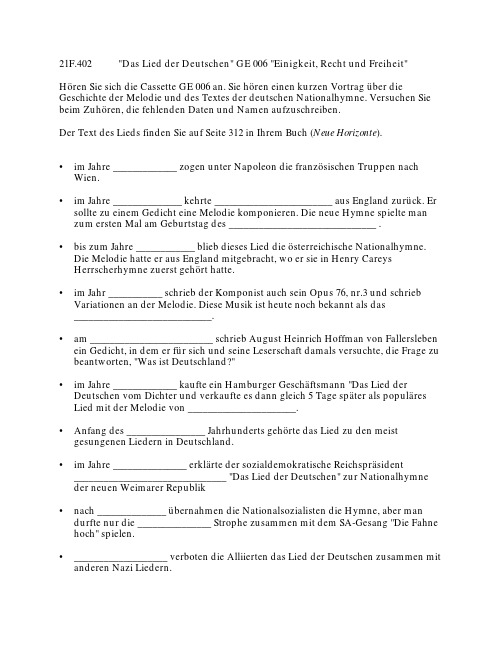
21F.402 "Das Lied der Deutschen" GE 006 "Einigkeit, Recht und Freiheit"Hören Sie sich die Cassette GE 006 an. Sie hören einen kurzen Vortrag über die Geschichte der Melodie und des Textes der deutschen Nationalhymne. Versuchen Sie beim Zuhören, die fehlenden Daten und Namen aufzuschreiben.Der Text des Lieds finden Sie auf Seite 312 in Ihrem Buch (Neue Horizonte).• im Jahre _____________ zogen unter Napoleon die französischen Truppen nach Wien.• im Jahre ______________ kehrte ________________________ aus England zurück. Er sollte zu einem Gedicht eine Melodie komponieren. Die neue Hymne spielte man zum ersten Mal am Geburtstag des ______________________________ .• bis zum Jahre ____________ blieb dieses Lied die österreichische Nationalhymne.Die Melodie hatte er aus England mitgebracht, wo er sie in Henry CareysHerrscherhymne zuerst gehört hatte.• im Jahr ___________ schrieb der Komponist auch sein Opus 76, nr.3 und schrieb Variationen an der Melodie. Diese Musik ist heute noch bekannt als das____________________________.• am _________________________ schrieb August Heinrich Hoffman von Fallersleben ein Gedicht, in dem er für sich und seine Leserschaft damals versuchte, die Frage zu beantworten, "Was ist Deutschland?"• im Jahre _____________ kaufte ein Hamburger Geschäftsmann "Das Lied der Deutschen vom Dichter und verkaufte es dann gleich 5 Tage später als populäres Lied mit der Melodie von ______________________.• Anfang des ________________ Jahrhunderts gehörte das Lied zu den meist gesungenen Liedern in Deutschland.• im Jahre _______________ erklärte der sozialdemokratische Reichspräsident _______________________________ "Das Lied der Deutschen" zur Nationalhymne der neuen Weimarer Republik• nach ______________ übernahmen die Nationalsozialisten die Hymne, aber man durfte nur die _______________ Strophe zusammen mit dem SA-Gesang "Die Fahne hoch" spielen.• ___________________ verboten die Alliierten das Lied der Deutschen zusammen mit anderen Nazi Liedern.。
MIT-SCIENCE-Lectures-class6_2002
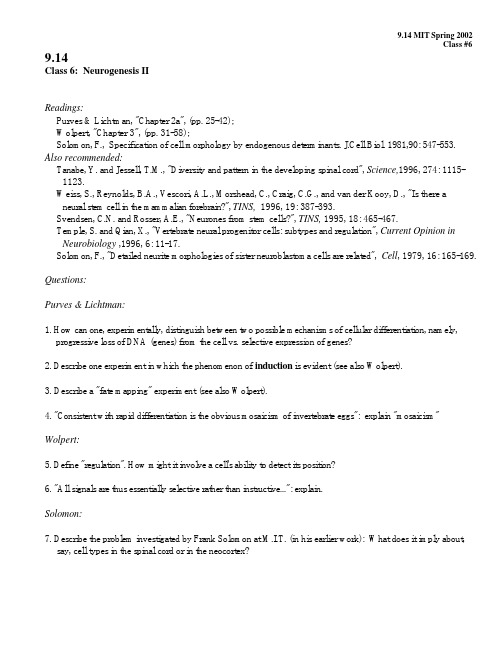
9.14 MIT Spring 2002Class #6 9.14Class 6: Neurogenesis IIReadings:Purves & Lichtman, "Chapter 2a", (pp. 25-42);Wolpert, "Chapter 3", (pp. 31-58);Solomon, F., Specification of cell morphology by endogenous determinants. J.Cell Biol. 1981,90: 547-553. Also recommended:Tanabe, Y. and Jessell, T.M., "Diversity and pattern in the developing spinal cord", Science,1996, 274: 1115-1123.Weiss, S., Reynolds, B.A., Vescori, A.L., Morshead, C., Craig, C.G., and van der Kooy, D., "Is there aneural stem cell in the mammalian forebrain?", TINS, 1996, 19: 387-393.Svendsen, C.N. and Rosser, A.E., "Neurones from stem cells?", TINS, 1995, 18: 465-467.Temple, S. and Qian, X., "Vertebrate neural progenitor cells: subtypes and regulation", Current Opinion in Neurobiology ,1996, 6: 11-17.Solomon, F., "Detailed neurite morphologies of sister neuroblastoma cells are related",Cell, 1979, 16: 165-169. Questions:Purves & Lichtman:1. How can one, experimentally, distinguish between two possible mechanisms of cellular differentiation, namely,progressive loss of DNA (genes) from the cell vs. selective expression of genes?2. Describe one experiment in which the phenomenon of induction is evident (see also Wolpert).3. Describe a "fate mapping" experiment (see also Wolpert).4. "Consistent with rapid differentiation is the obvious mosaicism of invertebrate eggs": explain "mosaicism" Wolpert:5. Define "regulation". How might it involve a cell's ability to detect its position?6. "All signals are thus essentially selective rather than instructive...": explain.Solomon:7. Describe the problem investigated by Frank Solomon at M.I.T. (in his earlier work): What does it imply about,say, cell types in the spinal cord or in the neocortex?。
MIT-SCIENCE-Lectures-sktn1
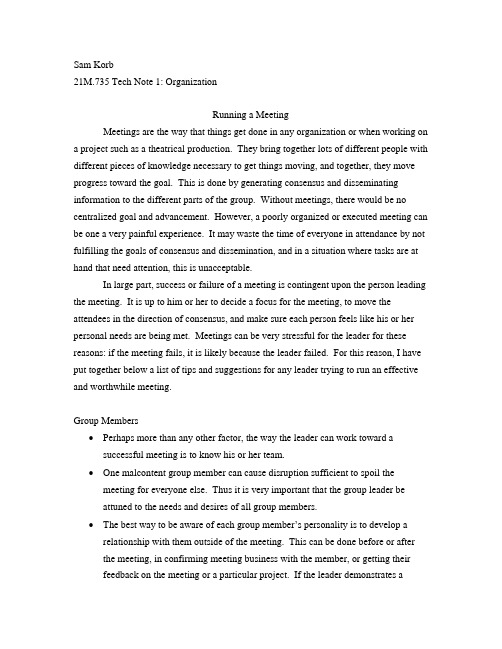
Sam Korb21M.735 Tech Note 1: OrganizationRunning a MeetingMeetings are the way that things get done in any organization or when working on a project such as a theatrical production. They bring together lots of different people with different pieces of knowledge necessary to get things moving, and together, they move progress toward the goal. This is done by generating consensus and disseminating information to the different parts of the group. Without meetings, there would be no centralized goal and advancement. However, a poorly organized or executed meeting can be one a very painful experience. It may waste the time of everyone in attendance by not fulfilling the goals of consensus and dissemination, and in a situation where tasks are at hand that need attention, this is unacceptable.In large part, success or failure of a meeting is contingent upon the person leading the meeting. It is up to him or her to decide a focus for the meeting, to move the attendees in the direction of consensus, and make sure each person feels like his or her personal needs are being met. Meetings can be very stressful for the leader for these reasons: if the meeting fails, it is likely because the leader failed. For this reason, I have put together below a list of tips and suggestions for any leader trying to run an effective and worthwhile meeting.Group Members•Perhaps more than any other factor, the way the leader can work toward a successful meeting is to know his or her team.•One malcontent group member can cause disruption sufficient to spoil the meeting for everyone else. Thus it is very important that the group leader beattuned to the needs and desires of all group members.•The best way to be aware of each group member’s personality is to develop a relationship with them outside of the meeting. This can be done before or afterthe meeting, in confirming meeting business with the member, or getting theirfeedback on the meeting or a particular project. If the leader demonstrates agenuine interest in the group members, they will return that respect during themeeting.•This is also a very good way to get dynamic feedback that will help the leader improve his or her skills, leading to better progress for the group as a whole. That is, if the leader is discussing a meeting that just happened, the member may point out that the particular needs of one of the group members wasn’t being met, thatthe leader may not have seen.Agendas• A good agenda is the backbone of a successful meeting. It provides guidance for the flow of the meeting, and makes sure all issues get their fair share of time.•It can be very helpful to make sure all group members get input into formulating the agenda before the meeting; e-mail is a great way to do this. It falls to theleader to decide what goes in and what doesn’t, but allowing everyone tocontribute decreases the chances that something will be missed.•Agendas should ideally be distributed a day or two before the meeting, to allow group members to prepare for the discussions or presentations, and to make surenothing got left out. It is also a good idea to have printed out copies of the agenda or an overhead projected copy at the meeting, so group members will be familiar with the agenda.•The leader must balance the need to keep to the agenda with the possibility of new business coming up in the course of discussion. He or she must determinewhen to stick by the agenda, and when to deviate. It can be helpful if new issues come up, rather than discussing them at the moment, to write them down andtable them for the end of the meeting or the next meeting.Meeting Flow• A good meeting length is one hour. This is usually long enough to cover all business, but not too long that it starts becoming trying to sit through it all. Ifthere is too much business for an hour, consider taking breaks in between.•The first meeting of any body can set the tone for the rest of the meetings. Thus it is very important that it flow smoothly and that the leader maintain a goodpresence. It is often helpful to agree as a group on some ground rules for themeeting: i.e. encouraging the input of all members, respecting different opinions, being mindful of the agenda, etc. These can be written on a large sheet of paper, and posted at subsequent meetings.•If time permits, it can be helpful at the first meeting to have group members introduce themselves and give some background as to their experiences andstrengths. This will give the members a better knowledge about each other, and make sure each person feels comfortable addressing the group.•The leader should be surveying the group members during the meeting, watching body language to catch unexpressed issues or feelings. He or she can call onpeople to speak who might not have otherwise expressed their opinions.Meetings can be stressful, but with a little advance planning and an eye to keeping members happy, almost anyone can be a successful leader.。
MIT-SCIENCE-Lectures-midterm1

MIT-SCIENCE-Lectures-midterm114.04Midterm Exam1Prof.Sergei IzmalkovWed,Oct1 1.Let(p t,y t)for t=1,...,N be a set of observed choices that satisfy WAPM,let Y I and Y O be the inner and outer bounds to the true production set Y.Letπ+(p),π(p),andπ?(p)be pro?t functions associated with Y O,Y,and Y I correspondingly.(a)Show that for all p,π+(p)≥π(p)≥π?(p).(b)If for all p,π+(p)=π(p)=π?(p),what you can say about Y O,Y,and Y I?Provide formalarguments.(c)For(p1,y1)=([1,1],[?3,4]),and(p2,y2)=([2,1],[?1,2])construct Y I and Y O(graphically).What can you say about returns to scale in the technology these observations are coming from?Hint:think y=(?x,y).2.Given the production function f(x1,x2,x3)=x a1min{x2,x3}a,(a)Calculate pro?t maximizing supply and demand functions,and the pro?t function.What re-striction you have to impose on a?(b)Fix y.Calculate conditional demands and the cost function c(w1,w2,y).(c)Solve the problem py?c(w1,w2,y)→m ax y,do you obtain the same solution as in2a?Explainyour?ndings.3.Given the production function f(x1,x2)=x1+x b2,whereb>0,calculate the cost function c(1,1,y).How would costs respond to the changes in w1,w2,and y?How would factor demands respond? 4.Consider a?rm with conditional factor demand functions of the form(output has beenset equal to1for convenience):x1=1+w?131w a2,x2=1+dw b1w c2.What are the values of the parameters a,b,c,and d and why?5.The cost function is c(w1,w2,y)=w a1w b2y d.(a)What do we know about a and b?(b)What are the conditional factor demands?What is the production function?(c)What can you tell about returns to scale?6.Let c(w1,w2,ˉy)=ˉc(ˉy)be the isocost and y=f(x1,x2)=ˉy be the isoquant corresponding to a?xedoutpu t levelˉy=1.(a)What are the slopes of these lines?(b)Draw the isocost and isoquant for Cobb-Douglas technology y=x121x122corresponding toˉy=1.(c)Suppose c(w1,w2,1)=aw1+bw2.Draw the isocost and the corresponding isoquant(use theslopes to obtain the shape of the isoquant).(d)Repeat for c(w1,w2,1)=min{aw1,bw2}.(e)Draw conditional demand x1as a function of w1w2for7c and7d.Hint:If you have trouble in7c?7e,think what technology these costs came from.1。
MIT-SCIENCE-Lectures-assignment_3(1)
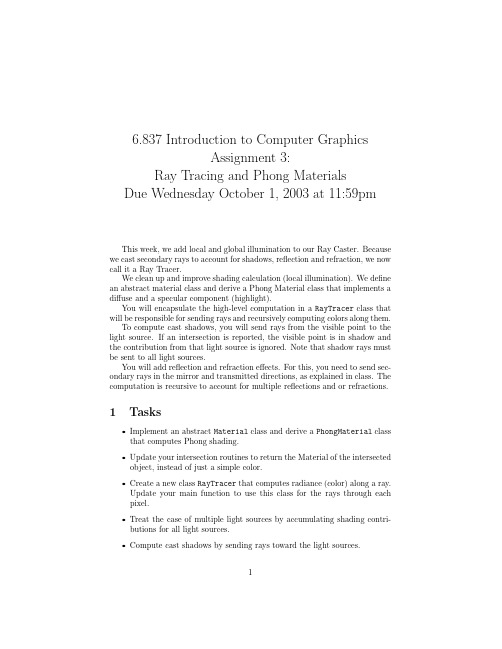
6.837Introduction to Computer GraphicsAssignment3:Ray Tracing and Phong MaterialsDue Wednesday October1,2003at11:59pm This week,we add local and global illumination to our Ray Caster.Because we cast secondary rays to account for shadows,reflection and refraction,we now call it a Ray Tracer.We clean up and improve shading calculation(local illumination).We define an abstract material class and derive a Phong Material class that implements a diffuse and a specular component(highlight).You will encapsulate the high-level computation in a RayTracer class that will be responsible for sending rays and recursively computing colors along them.To compute cast shadows,you will send rays from the visible point to the light source.If an intersection is reported,the visible point is in shadow and the contribution from that light source is ignored.Note that shadow rays must be sent to all light sources.You will add reflection and refraction effects.For this,you need to send secondary rays in the mirror and transmitted directions,as explained in class.The computation is recursive to account for multiple reflections and or refractions. 1Tasks• Implement an abstract Material class and derive a PhongMaterial class that computes Phong shading.• Update your intersection routines to return the Material of the intersected object,instead of just a simple color.• Create a new class RayTracer that computes radiance(color)along a ray.Update your main function to use this class for the rays through each pixel.• Treat the case of multiple light sources by accumulating shading contributions for all light sources.• Compute cast shadows by sending rays toward the light sources.1• Compute perfect mirror reflection by sending rays recursively in the mirror direction.• Compute transparency effects by sending rays recursively in the refracted direction.• Provide a README.txtfile that discusses any problems you encountered, how long it took to complete the assignment,any extra credit work that you did and how we can test the new features.• Extra credit:semi-transparent shadows where the attenuation depends on the distance traveled in the transparent object;nested refracting materials;shadow ray acceleration using early termination and without returning the normal and material;Fresnel reflection term;other BRDF models such as Cook-Torrance or Ward;anisotropic BRDFs;solid textures.2Classes you need to update/writeThe Object3D and Hit classes must now store more detailed information about the properties of the surface,encapsulated in a Material class.You must update your Object3D class(and the constructors of all subclasses)to replace the color by a pointer to a Material.You must also update your intersection routines so that they return a pointer to a Material and not a color in case of an intersection.2.1Material and PhongMaterialThe Material class has a pure virtual method Shade that computes the local interaction of light and the material.It takes as input the viewing ray,the Hit data structure,and light information.virtual Vec3f Material::Shade(const Ray&ray,const Hit&hit,const Vec3f&dirToLight,const Vec3f&lightColor)const=0;In addition to the diffuse object color used in the last assignment,the Material class stores information about transparency and reflection.It must store two colors for the reflection and transparency coefficients,and an index of refraction.You must implement accessor functions for thesefields. Material::Material(const Vec3f&diffuseColor,const Vec3f&transparentColor,const Vec3f&reflectiveColor,float indexOfRefraction);You must derive a subclass PhongMaterial that computes shading using both a diffuse and specular term.The class takes as additional parameters a specular color and a scalar exponent.The constructor expected by the parser is:2PhongMaterial::PhongMaterial(const Vec3f&diffuseColor, const Vec3f&specularColor,float exponent,const Vec3f&transparentColor,const Vec3f&reflectiveColor,float indexOfRefraction);Implement the PhongMaterial::Shade function using the version of the Phong model taught in class based on the angle between the eye ray and the reflected ray.2.2RayTracerThe RayTracer class encapsulates the computation of radiance(color)along rays.It stores a pointer to the SceneParser for access to the geometry and light sources.The constructor is:RayTracer(SceneParser*s,int max_bounces,float min_weight);The main method of this class is traceRay that,given a ray,computes the color seen from the origin along the direction.This computation can be recursive because of reflection and refraction.We therefore need a stopping criterion to prevent infinite recursion.traceRay takes as additional parameters the current number of bounces(recursion depth)and a ray weight that indicates how much the contribution will be dimmed in thefinal image.The corresponding maximum recursion depth and the minimum ray weight arefields of RayTracer, which are passed as command line arguments to the program.Note that the weight is a scalar that corresponds to the magnitude of the color vector.Vec3f traceRay(Ray&ray,float tmin,int bounces,float weight,float indexOfRefraction,Hit&hit)const;First,implement traceRay so that it computes the closest intersection with the scene and performs shading.For ambient lighting,you should use the getDiffuseColor method of the Material pointer stored by Hit and multiply it by the ambient light of the SceneParser.Add the contributions of the light sources in the scene by iterating over the light sources stored by the SceneParser and call the Shade method of the Material.ShadowsNext,you need to implement cast shadows.Modify the code described above to test for each light whether the line segment joining the intersection point and the light source intersects an object.If there is an intersection,then discard the contribution of that light source.Recall that you must displace the ray origin slightly away from the surface,or equivalently set tmin as�.Note that in this ¨naive version,semi-transparent objects still cast opaque shadows.Implement something better for extra credit.3Mirror reflectionYou will then implement mirror reflection.This involves the use of secondary rays in the direction symmetric with respect to the normal.If the material isreflective(getReflectiveColor()>(0,0,0)),then you must create a new ray with origin the current intersection point,and direction the mirror direction. For this,we suggest you write a function:Vec3f mirrorDirection(const Vec3f&normal,const Vec3f&incoming);Trace the secondary ray with a recursive call to traceRay using modified values for the recursion depth and ray weight.The ray weight is simply multiplied by the magnitude of the transparency color.Make sure that traceRay checks these stopping conditions.For the attenuation,check if the magnitude of the color is smaller than the maximum weight.Add the reflected contributionto the color computed for the current ray.Don’t forget to take into account thereflection coefficient of the material.RefractionFinally,you will implement the computation of transmitted rays.For semitransparent objects,you will trace a new ray in the transmitted direction.We suggest you implement a function transmittedDirection that given an incident vector,a normal and the indices of refraction,returns the transmitted direction.bool transmittedDirection(const Vec3f&normal,const Vec3f&incoming, float index_i,float index_t,Vec3f&transmitted);Be careful about the direction of the vectors and the ratio of indices.We make the simplifying assumption that our transparent objects exist in a vacuum, with no intersecting or nested refracting materials.This allows us to determine the incident and transmitted index of refraction simply by looking at the dot product between the normal and the incoming ray.Indeed,because we now consider transparent objects,we might hit the surface of a primitive from either side,depending on whether we were inside or outside the object.Note that the dot product of the normal and ray direction is negative when we are outside the object,and positive when we are inside.You will use this to detect whether the new index of refraction is1or the index of the hit object.(The index of refraction for the material surrounding the ray origin is passed as an argumentto traceRay.)If you are inside the object,you mustflip the normal before computing the transmitted direction.It is not necessary toflip the normal when computing the direction of the reflected ray(you’ll get the same answer). For shading,use the original normal.4RecapTo summarize,the color returned by traceRay is the sum of the ambient contribution,the shading contribution of the visible light sources,the mirror reflection and the transmitted contribution.3Updated Utilities ProvidedHit.hHit has been modified to store the material of the intersection point.We provide you with the updatedfile.Light(light.h)Updated to include point light sources.Also getIllumination()now also provides the distance to the light source,which is important for shadow rays.Parsing inputfiles(scene_parser.h,and scene_parser.C) Thesefiles have been updated to parse the point light sources and Phong materials.The PhongMaterial constructor you will write is called from the parser.Look in the scene_parser.Cfile for details.Command line argumentsIn addition to the parameters used in the previous assignments,your program should take the maximum number of bounces,and the cutofffor ray weight as command line arguments.Make sure the following example works,as this is how we will test your program:raytracer-input scene.txt-output out.tga-bounces5-weight0.014Hints• You do not need to declare virtual all methods in a class,only the ones which subclasses will override.• Print as much information as you need for debugging.When you get weird results,don’t hesitate to use simple cases,and do the calculations manually to verify your results.Perhaps instead of casting all the rays needed to create an image,just cast a single ray(and its corresponding ray tree).• Modify the test scenes to reduce complexity for debugging:remove objects,remove light sources,change the parameters of the materials so that you can view the contributions of the different components,etc.• Comment your code,we take this into account when grading.5。
MIT-SCIENCE-Lectures-paper2(3)
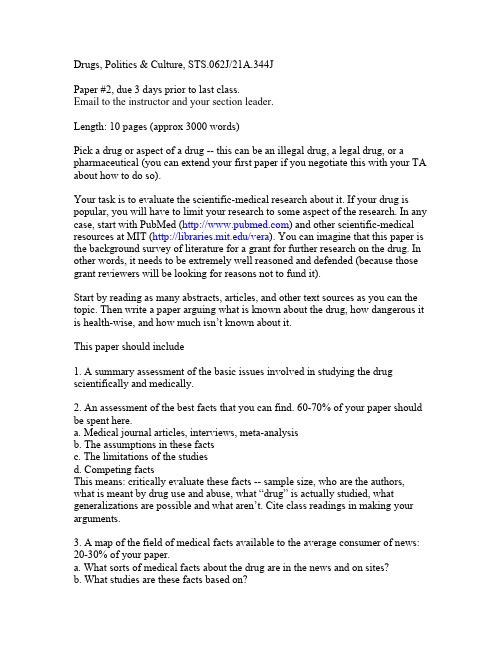
Drugs, Politics & Culture, STS.062J/21A.344JPaper #2, due 3 days prior to last class.Email to the instructor and your section leader.Length: 10 pages (approx 3000 words)Pick a drug or aspect of a drug -- this can be an illegal drug, a legal drug, or a pharmaceutical (you can extend your first paper if you negotiate this with your TA about how to do so).Your task is to evaluate the scientific-medical research about it. If your drug is popular, you will have to limit your research to some aspect of the research. In any case, start with PubMed () and other scientific-medical resources at MIT (/vera). You can imagine that this paper is the background survey of literature for a grant for further research on the drug. In other words, it needs to be extremely well reasoned and defended (because those grant reviewers will be looking for reasons not to fund it).Start by reading as many abstracts, articles, and other text sources as you can the topic. Then write a paper arguing what is known about the drug, how dangerous it is health-wise, and how much isn’t known about it.This paper should include1. A summary assessment of the basic issues involved in studying the drug scientifically and medically.2. An assessment of the best facts that you can find. 60-70% of your paper should be spent here.a. Medical journal articles, interviews, meta-analysisb. The assumptions in these factsc. The limitations of the studiesd. Competing factsThis means: critically evaluate these facts -- sample size, who are the authors, what is meant by drug use and abuse, what “drug” is actually studied, what generalizations are possible and what aren’t. Cite class readings in making your arguments.3. A map of the field of medical facts available to the average consumer of news: 20-30% of your paper.a. What sorts of medical facts about the drug are in the news and on sites?b. What studies are these facts based on?c. How does this compare with your evaluation of the sci-med literature?d. How do you account for discrepancies (how are facts circulating)?Research the fields of facts and controversies around it, especially the news media (NOT just websites). Use google and https:///universe, but DO NOT make the mistake of arguing that these = research. Cite class readings in making your argument.4. Conclude by discussing what isn’t known. What sorts of studies (specifically) might be better?Grading:A papers will be well-written, without grammar or spelling problems, well- structured, properly footnoted. They will contain analysis using concepts from class (including citations). The arguments will provide defended evidence and a critique of that evidence.B papers will be well-written, without grammar or spelling problems, well- structured, properly footnoted. The arguments will provide defended evidence.C papers will be well-written, well-structured, properly footnoted. They will contain arguments with evidence.All papers need to be well-argued. This means that when you make any claim you provide the reader with a clear means to understand what evidence you based your claim on (reasons), and the means to check that evidence (footnotes).。
MIT-SCIENCE-Lectures-18arndel_chrlina
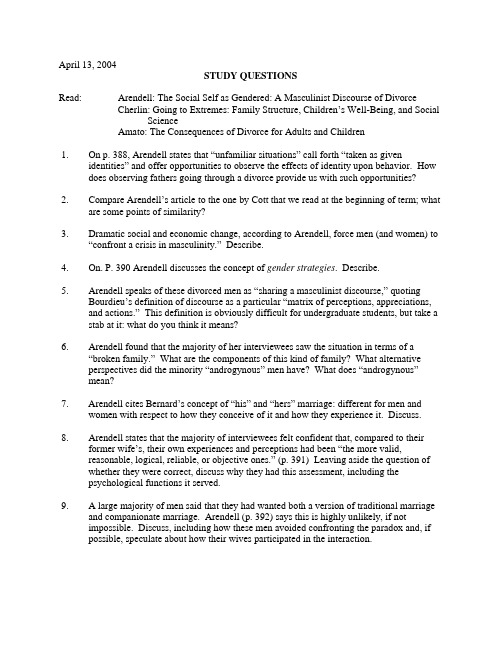
April 13, 2004STUDY QUESTIONSRead: Arendell: The Social Self as Gendered: A Masculinist Discourse of Divorce Cherlin: Going to Extremes: Family Structure, Children’s Well-Being, and Social ScienceAmato: The Consequences of Divorce for Adults and Children1. On p. 388, Arendell states that “unfamiliar situations” call forth “taken as givenidentities” and offer opportunities to observe the effects of identity upon behavior. How does observing fathers going through a divorce provide us with such opportunities?2. Compare Arendell’s article to the one by Cott that we read at the beginning of term; whatare some points of similarity?3. Dramatic social and economic change, according to Arendell, force men (and women) to“confront a crisis in masculinity.” Describe.4. On. P. 390 Arendell discusses the concept of gender strategies. Describe.5. Arendell speaks of these divorced men as “sharing a masculinist discourse,” quotingBourdieu’s definition of discourse as a particular “matrix of perceptions, appreciations, and actions.” This definition is obviously difficult for undergraduate students, but take a stab at it: what do you think it means?6. Arendell found that the majority of her interviewees saw the situation in terms of a“broken family.” What are the components of this kind of family? What alternativeperspectives did the minority “androgynous” men have? What does “androgynous”mean?7. Arendell cites Bernard’s concept of “his” and “hers” marriage: different for men andwomen with respect to how they conceive of it and how they experience it. Discuss.8. Arendell states that the majority of interviewees felt confident that, compared to theirformer wife’s, their own experiences and perceptions had been “the more valid,reasonable, logical, reliable, or objective ones.” (p. 391) Leaving aside the question ofwhether they were correct, discuss why they had this assessment, including thepsychological functions it served.9. A large majority of men said that they had wanted both a version of traditional marriageand companionate marriage. Arendell (p. 392) says this is highly unlikely, if notimpossible. Discuss, including how these men avoided confronting the paradox and, ifpossible, speculate about how their wives participated in the interaction.2 10. On p. 393 Arendell uses a roundabout way to discuss empathy (“assume the attitude ofthe other individual as well as calling it out in the other”). Do you think that women are more empathic than men? Why or why not? With what results for marital interaction?11. Describe differences between the divorced mother and father with respect to theirchildren for the majority of interviewees.12. Many of the interviewees spoke of distancing themselves from their children. Why?13. Why, do you suppose, do ambivalent and negative feelings about the former wife remainintense for over a third of the interviewees (p. 397)?14. Discuss how the interviewees employed a “rhetoric of rights.”15. How did the androgynous fathers differ from the majority of fathers?16. Compare what Cherlin says about the effect of divorce on children with what Coontzsays.17. “Growing up in a single-parent family or a stepfamily is associated with a lower level ofwell-being and poorer life outcomes than living in a family with two biological parents”(p. 286). What more do we need to know in order to know something useful?18. What is Cherlin’s critique of Wallerstein’s findings?19. Amato speaks about “the ongoing, contentious debate over the consequences of maritaldisruption for adults and children” (p. 191). Characterize this debate.20. Why would thinking of divorce as a process rather than event be worthwhile?21. What is “the selection perspective” (p. 196)?22. What is the evidence supporting the perspective on divorce as a crisis? On seeing it interms of chronic strain?23. What are the major mediators of divorce effects?。
MIT-SCIENCE-Lectures-lecnotes_03_04
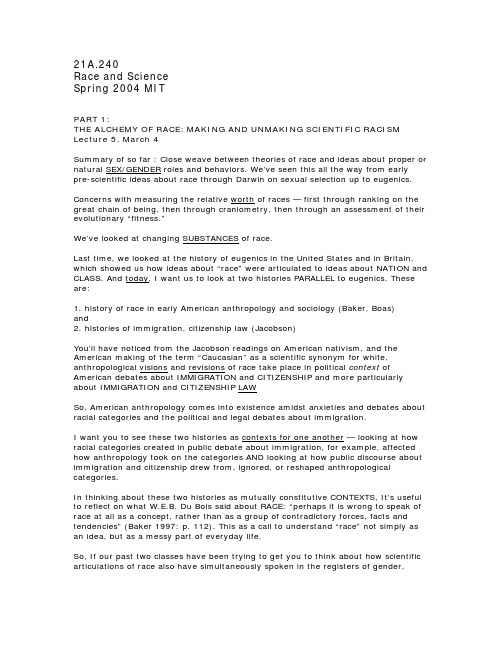
21A.240Race and ScienceSpring 2004 MITPART 1:THE ALCHEMY OF RACE: MAKING AND UNMAKING SCIENTIFIC RACISM Lecture 5. March 4Summary of so far : Close weave between theories of race and ideas about proper or natural SEX/GENDER roles and behaviors. We’ve seen this all the way from earlypre-scientific ideas about race through Darwin on sexual selection up to eugenics.Concerns with measuring the relative worth of races — first through ranking on the great chain of being, then through craniometry, then through an assessment of their evolutionary “fitness.”We’ve looked at changing SUBSTANCES of race.Last time, we looked at the history of eugenics in the United States and in Britain, which showed us how ideas about “race” were articulated to ideas about NATION and CLASS. And today, I want us to look at two histories PARALLEL to eugenics. These are:1. history of race in early American anthropology and sociology (Baker, Boas)and2. histories of immigration, citizenship law (Jacobson)You’ll have noticed from the Jacobson readings on American nativism, and the American making of the term “Caucasian” as a scientific synonym for white, anthropological visions and revisions of race take place in political context of American debates about IMMIGRATION and CITIZENSHIP and more particularly about IMMIGRATION and CITIZENSHIP LAWSo, American anthropology comes into existence amidst anxieties and debates about racial categories and the political and legal debates about immigration.I want you to see these two histories as contexts for one another — looking at how racial categories created in public debate about immigration, for example, affected how anthropology took on the categories AND looking at how public discourse about immigration and citizenship drew from, ignored, or reshaped anthropological categories.In thinking about these two histories as mutually constitutive CONTEXTS, It’s useful to reflect on what W.E.B. Du Bois said about RACE: “perhaps it is wrong to speak of race at all as a concept, rather than as a group of contradictory forces, facts and tendencies” (Baker 1997: p. 112). This as a call to understand “race” not simply as an idea, but as a messy part of everyday life.So, If our past two classes have been trying to get you to think about how scientific articulations of race also have simultaneously spoken in the registers of gender,class, nation, and state, today, I want you to think about the relation between SCIENCE, RACE, AND LAW.Skin Color, Bodily Form: Laws of Science and Laws of the Land in the Context of Immigration, Assimilation and Early 20th-Century American AnthropologyJacobson, Matthew Frye. 1998. Race and American Nativism, from Anglo-Saxons and Others, 1840-1924. In Whiteness of a Different Color: European Immigrants and the Alchemy of Race. Cambridge: Harvard University Press, pp. 68-90.Stocking, George, Jr. 1994. The Turn-of-the-Century Concept of Race. Modernism/Modernity 1:1: pp. 4-16.Baker, Lee. 1997. Rethinking Race at the Turn of the Century: W.E.B. Du Bois and Franz Boas. In From Savage to Negro: Anthropology and the Construction of Race, 1896-1954. Berkeley: University of California Press, pp. 99-126.Boas, Franz. 1913. Changes in Bodily Form of Descendents of Immigrants. In Race, Language and Culture. New York: The Free Press/Macmillan, 1966, pp. 60-75.Jacobson, Matthew Frye. 1998. Becoming Caucasian, 1924-1965 & Naturalizationand the Courts. In Whiteness of a Different Color: European Immigrants and the Alchemy of Race. Cambridge: Harvard University Press, pp. 91-109, pp. 223-240.ANTHROPOLOGY AND SOCIOLOGYLet’s start with the Stocking piece:G. Stanley Hall, president of Clark University, remarking on a paper he heardin 1895 on "The Scotch-Irish in America"made it clear that much more was involved in the "commingling of bloods"than simply physical characteristics. "The combination of racial bloods is not amere matter of biology or physiology...because physical inheritance does notinclude mere physical mingling of the bloods, but [also] that subtleatmosphere of associations, of home traditions, of family recollections andideals and aims, that are so inseparable.""Blood"--and by extension "race"--included numerous elements that we wouldtoday call cultural; there was not a clear line between cultural and physicalelements or between social and biological heredityStocking is showing us how many, different, separate features of humansocial life are confused, conflated by Hall, mixed together.Stocking argues that there were four traditions of thinking about humandifference that were usedThe ETHNOLOGICAL: language, food, custom, etc,The LAMARCKIAN: inheritance of acquired characteristics, couldn’t distinguish between cultural and biological inheritance (before ideas about heredity). POLYGENISM: idea that God had created human groups separately EVOLUTIONISM: but with idea that some groups are more evolved than others.It was all of these that FRANZ BOAS was interested in demolishing.How?1. Separate biology from culture.2. Use Darwinian theory to refute Lamarck,3. Argue for the unity of humanity4. Argue that evolution does not imply ranking (that is an old great chain of being idea) and that cultures must be studied on their own terms.Let’s go back to Hall’s idea about"The combination of racial bloods is not a mere matter of biology or physiology...because physical inheritance does not include mere physical mingling of the bloods, but [also] that subtle atmosphere of associations, of home traditions, of family recollections and ideals and aims, that are so inseparable."Boas would SEPARATE these strandsRACE, LANGUAGE, and CULTURE have different histories.Boas is responsible for defining CULTURE in the way we think about it today. Before Boas, CULTURE meant opera, oil paintings — and only Europeans had it.But, having separated CULTURE from BIOLOGY, what did this make RACE for BOAS? See his 1913 article, in which he demonstrates that children of immigrants to US look different from their parents. (an intervention in immigration debates)What did RACE become for BOAS? PlasticWhat’s really tricky here is that RACE still exists for BOAS-MOVEOVER, RACE IS always negative for BOAS.This means that he’s still trapped in the game — that there is something there in biology; he’s still using the categories of his day (see Baker 119)W.E.B. DU BOIS had a different approach. What was it?“perhaps it is wrong to speak of race at all as a concept, rather than as a group of contradictory forces, facts and tendencies” (Baker 1997: p. 112).Race is fully sociological; invented in the context of power and inequality. (p.111).And THIS is where the context of IMMIGRATION LAW in the UNITED STATESduring this period comes in.IMMIGRATION AND NATURALIZATIONThe concept of race forged and re-forged in the context of who could count asa citizen capable of rational self-government and immigration debates.1840-1924, question of who could be a Citizen of the US depended uponwhether people were considered capable of self-government, organizedaround what we would now call regional/national identities (Germanic,Mediterranean, Hebrew, Irish, Italian, etc.) but which back then wereracialized identities.To “naturalize” — and note the word! Getting citizenship AS IF being born inUS (US grants citizenship on birth on land — not all nations do this; e.g.Germany):1790 “any alien being a free white person”1870 added “aliens of African nativity and persons of African descent”1882: Chinese Exclusion Act, explicitly excluded Chinese, (who had beencoming from Canton because of the Gold Rush in California) lasts until 1943[about when Japanese internment starts!))Celts, Hebrews, Italians becoming less white in terms of who should appearon shore, but more white in terms of who could be citizens (p. 75).Immigration Restriction League 1893 (p. 77).anti-miscegenation laws (some state laws on books until 1967, 1948 in CA) some of these laws specified that a US citizen woman, if shemarried an alien ineligible for citizenship would lose her citizenship(only other thing you lose citizenship for is TREASON)treated women as property of a “race”; white women property of whitemen.of a piece with anti-immigration laws, regulating “reproduction” of thenation and its favored constituents.also kept “races” distinct by forcing immigrant groups into their owncommunities, thereby reproducing communities of people who werejudged according to those categories.Davenport: nation as race at Cold Spring Harbor1907 gentlemen’s agreement: stopped immigration of Japanese people to US.1911 Dillingham Commission Report on Races and Peoples; used Blumenbach’s 5 races, but also recognized “45 races among immigrants coming to the US” (p. 78). (p. 79: quote of use in analyzing Boas 1913!!! [names the very categories he’s using]).Dillingham commission saw immigrants as parents of future Americans (since citizenship is conferred by birth!), and so inquired into their fitness to be included in national germ plasm (eugenic concern) (pp. 82-83).1924: Johnson Act: 2% quotas for immigrants based on 1890 census.After 1924, a shift from ranking specific “races” like “Mediterranean” or “Irish” to the beginning of the consolidation of a “Caucasian” racial formation; all these types BECOME Caucasian.“Caucasian” supposedly a more “scientific” term than “white” (more thanskin-deep) [Jacobson p. 94]Race politics get reorganized around black-white“as scientists asserted over and over that “Aryans,” “Jews,” “Italians,” “Nordics,” and the like were not races, their myriad assertions themselves all buttressed an edifice founded upon three grand divisions of mankind—‘Caucasian,’ ‘Mongoloid’, and ‘Negroid’ — whose differences by implication were racial” (Jacobson p. 103)“Races of Mankind” exhibit 1943: nationalities are not races, the Jews are not a race, etc. “what is an American?” EXHIBIT WAS A LESSON IN CIVICS. Naturalization and the CourtsWhy is whiteness so important, legally?it’s about assignation of property rightswhiteness AS property (Lockean property in self, and right to own property) legal disputes: “Hey, I’m white!”“Between the 1870s and the 1920s the court generated their own epistemology of race that drew from scientific doctrine, from popular understanding, from historical reasoning, from “common-sense ideas, from geography, from precedent” (p. 226 quote)Ah Yup 1878 applied to be white: judge said that he was Mongolian and couldn’t be CaucasianHalladjian 1909 Armenians judged white because they were “Caucasian” even if not “European” but their inclusion was still based on the “fact” they were lighter than many Europeans — like the Portuguese — and also that white meant anyone who wasn’t AfricanLet’s take a look in depth at two famous court cases in which people sought to be classified as “white/Caucasian” in order to “naturalize” as citizens. These demonstrate the slide between Aristotelian and Prototypicalclassification employed by those in power to consolidate social hierarchy (see discussion in Jacobson):Ozawa (1922): “you may be white, but you are not Caucasian” science Thind (1923): “you may be Caucasian, but you are not white” common-sense“‘Caucasian’ did accomplish something that the more casual notion of whiteness could not: it brought the full authority of science to bear on white identity.” (p. 94).。
MIT-SCIENCE-Lectures-123final2001v2
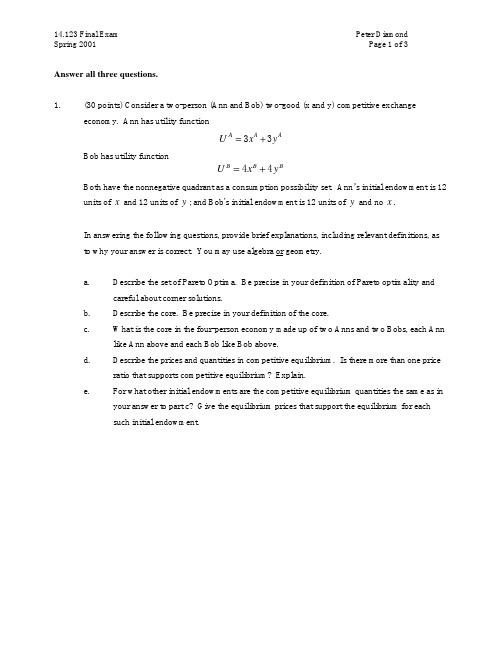
Both have the nonnegative quadrant as the consumption possibility set and each has an initial endowment of 4 apples. There is a single competitive firm that can convert apples into applesauce. If it uses x f apples, it produces 3 x f units of applesauce. The firm is owned by Ann. a. Determine competitive equilibrium prices and quantities. Is equilibrium Pareto optimal? Explain. b. The government is committed to seeing that each person consumes at least one unit of apples (called the apple-eating constraint). Subject to this apple-eating constraint, find an allocation that maximizes 6U A + 4U B . Describe a tax (and lump-sum transfer) policy that can achieve this Pareto optimum starting from initial endowments. If there is more than one allocation that satisfies the apple-eating constraint and maximizes 6U A + 4U B , describe tax (and lump-sum transfer) policies that can achieve all of these Pareto optima. c. If transaction taxes (that is, the tax on buying consumer goods) must be the same for all consumers, describe a tax (and lump-sum transfer) policy that maximizes 6U A + 4U B subject to the apple-eating constraint. d. If transaction taxes must be the same for all consumers, describe a tax (and lump-sum transfer) policy that maximizes 6U A + 4U B if there is no apple-eating constraint.
- 1、下载文档前请自行甄别文档内容的完整性,平台不提供额外的编辑、内容补充、找答案等附加服务。
- 2、"仅部分预览"的文档,不可在线预览部分如存在完整性等问题,可反馈申请退款(可完整预览的文档不适用该条件!)。
- 3、如文档侵犯您的权益,请联系客服反馈,我们会尽快为您处理(人工客服工作时间:9:00-18:30)。
An important and easy-to-neglect issue in building the frame is the weight of the water it will need to support.One cubic foot of water contains about 71/2 gallons and weighs approximately 63 pounds [2]. For a pool of any reasonable size, this quickly adds up; for large volumes of water, careful structural analysis will be important to ensure that the frame will be able to hold the weight, especially if the pool is being recessed into a platform. One simple way to minimize the amount of water used and thus the amount of weight that must be supported is to make the pool less deep; this is often a very reasonable option since the actual depth of the pool will always not be obvious to the audience.The frame should then be covered with plywood (given the loads it will be sup-porting, something substantial like 3/4 ′′ plywood should be used. It then needs to be covered with a pond liner so that it can be filled with water. These are readily available from garden stores as waterproof plastic sheets, which can be cut to size and fit into the pool.The pool can then be filled with water. Once filled, it should be emptied or changed regularly — the last thing anyone needs on the stage is a place for bacteria and other unpleasant things to grow, and a stagnant pool of water fits that bill all too well. A pool treatment can also be useful here, though ones containing chlorine are not ideal due to their distinctive smell.3 Building the waterfallMany of the same techniques from building a pool of water apply to building a waterfall. Again, we will need to use a waterproof pond liner around a frame and support structure. The difference, of course, is that the waterfall will be a stream (albeit one that sometimes flows horizontally and sometimes flows vertically), so it will not have as much depth.This allows the support structure to be more lightweight.A common means for building streams is to construct a set of curved ribs, then lay a thin layer of plywood or lauan over it that conforms to the curve of the ribs. This should then be covered with the pond liner.The water should flow through the stream and down the waterfall into the pool, which serves as a reservoir. It then needs to be returned to the top of the waterfall; for this, a pump is required. A household sump pump, available from the Home Depot or similar hardware store in the $100 range, is probably the easiest option.ℵ0-2For especially large installations, a common pump may not suffice. One option is to obtain a larger pump; McMaster-Carr carries sump pumps up to 3/4 hp and effluent pumps up to 2 hp, though the latter may be a bit expensive for this purpose at over $700[3]. A simple alternative is to use multiple smaller pumps. Submersible pumps are best for this application: other types of pumps may allow the pump to be placed further away from the pool, reducing noise, but adding a drain to the pool requires creating and sealing a hole in the liner, which only adds complexity. Sump pumps may pump into a standard garden hose, which is certainly easy to find and easy to work with. However, the pump will be able to operate more efficiently if PVC pipe (usually or 11/2 ′′ , though it depends on the pump) is used.11/4 ′′The pressure created by a pump, especially a large one, may be rather high. This could lead to the unusual effect of the water spewing forcefully upward or in a powerful stream — which, while useful for a fountain, isn’t very realistic in a stream effect.The solution here is to increase the diameter of the pipe by using couplers with successively larger diameters. This causes the same amount of water to flow through a larger area, and thus with less force.Waterfalls and streams are generally rather noisy. The sound of water flowing down the stream and into the pool can be a rather pleasant one, and can be a helpful part of the sound design for creating the outdoor atmosphere. If, however, that doesn’t fit with the sound designer’s vision, it becomes the technical designer’s problem to fix.Reducing the velocity of the flowing water is an obvious solution with an obvious drawback.Adding rocks and similar objects to the stream will help reduce the volume of water that needs to flow, reducing the noise created (and also allowing a smaller, quieter pump to be used). It is also quieter to not have water fall directly from the waterfall into the pool; instead, it should flow onto a surface that slopes into the pool.References[1] M. Powers, “Pools, waterfalls, etc.” available at /howto/water/pools.htm.[2] P. Carter, Backstage Handbook, 3rd ed. Louisville, Kentucky: Broadway Press,1994.ℵ0-3[3] McMaster-Carr, Inc. /.ℵ0-4。
